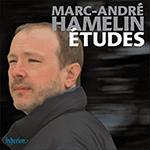Turning to Étude No 9,
after Rossini, I think I must have inherited a double-note gene! Double notes of any kind usually pose thorny problems, but they also yield textures of uncommon richness, and somehow it was my thought that this could be applied to Rossini’s wonderful song
La danza. I felt particularly cheerful and mischievous during the three or four days it took me to write this piece, and set about turning Rossini’s original practically upside-down, especially during the second couplet. Poor Rossini is subjected to sudden major-minor shifts, melodic inversions, a tune that starts a third too high, blue-note chords, and what amounts to something of a full-blown epileptic seizure towards the end. Also, for no particular reason, there is a slight allusion to the Gigue from Bach’s
Fifth French Suite.
from notes by Marc-André Hamelin © 2010
En me tournant vers l’Étude no 9,
d’après Rossini, je pense que j’ai dû hériter d’un gène de doubles notes! Les doubles notes de toutes sortes posent généralement des problèmes épineux, mais elles produisent aussi des textures d’une rare richesse et, d’une manière ou d’une autre, j’ai pensé que cela pourrait s’appliquer à la merveilleuse chanson de Rossini
La danza. Je me suis senti particulièrement joyeux et espiègle pendant les trois ou quatre jours que j’ai mis à écrire cette pièce et je me suis mis à tourner l’original de Rossini dans tous les sens ou presque, surtout le deuxième couplet. Le pauvre Rossini est soumis à de brusques changements majeur-mineur, à des renversements mélodiques, à un air qui commence une tierce trop haut, à des accords de blue-notes et à ce qui ce résume à une sorte de crise d’épilepsie à grande échelle vers la fin. En outre, sans raison particulière, il y a une légère allusion à la Gigue de la
Cinquième Suite française de Bach.
extrait des notes rédigées par Marc-André Hamelin © 2010
Français: Marie-Stella Pâris
Mit einem Blick auf Etüde Nr. 9
after Rossini muss ich gestehen, dass ich wohl ein angeborenes Doppelgriff-Gen habe! Doppelgriffe jeder Art sind normalerweise Ursache für heikle Probleme; sie können aber auch einen Klaviersatz ungewöhnlich bereichern, und irgendwie kam ich auf die Idee, dass das bei Rossinis wundervollem Lied
La danza funktionieren könnte. Ich war in einer ganz besonders fröhlichen und gleichzeitig spitzbübischen Stimmung während der drei oder vier Tage, die ich für die Komposition dieses Stückes benötigte, und machte mich daran, Rossinis Original praktisch auf den Kopf zu stellen, vor allem während des zweiten Couplets. Der arme Rossini ist nun plötzlichen Dur-Moll-Wechseln ausgesetzt, melodischen Umkehrungen, einer Melodie, die eine Terz zu hoch beginnt, Akkorden mit Blue Notes, und welche Steigerung zu einer Art totalem epileptischen Anfall gegen Ende! Bei 1'05 ist ohne speziellen Grund auch noch eine leichte Anspielung auf die Gigue aus Bachs
Französischer Suite Nr. 5 zu hören.
aus dem Begleittext von Marc-André Hamelin © 2010
Deutsch: Ludwig Madlener


 Hamelin: Études
Hamelin: Études
